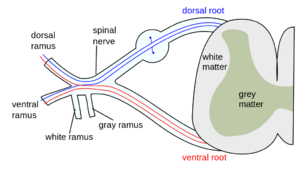Spinal Nerves
Original Editor - Lucinda hampton
Top Contributors - Lucinda hampton, Kim Jackson and Ahmed M Diab
Introduction[edit | edit source]
Spinal nerves are mixed nerves that send motor, sensory, and autonomic signals between the CNS and the body, and belong to the peripheral nervous system (PNS).
Humans have 31 left–right pairs of spinal nerves, each roughly corresponding to a segment of the vertebral column: eight cervical spinal nerve pairs, 12 thoracic pairs , five lumbar pairs, five sacral pairs, and one coccygeal pair.[1]
Spinal nerves can be impacted by a variety injuries, and cause pain, weakness, or decreased sensation. eg A nerve entrapment occurs when there is pressure or compression of a spinal nerve, and it is the most common spinal nerve disorder; a nerve can be lacerated resulting in cessation of function.[2]
Sub Heading 2[edit | edit source]
Sub Heading 3[edit | edit source]
The spinal nerves form within a few centimeters of the spine on each side. Some groups of spinal nerves merge with each other to form a large plexus. Some spinal nerves divide into smaller branches, without forming a plexus.
A plexus is a group of nerves that combine with each other. There are five main plexi formed by the spinal nerves:
- Cervical Plexus
- Brachial Plexus
- Lumbar Plexus
- Sacral Plexus
- Coccygeal Plexus: Composed of the merging of nerves S4 through Co1, this plexus supplies motor and sensory control of the genitalia and the muscles that control defecation.[2]
Resources[edit | edit source]
- bulleted list
- x
or
- numbered list
- x
References[edit | edit source]
- ↑ Lumen learning Spinal nerves Available: https://courses.lumenlearning.com/boundless-ap/chapter/spinal-nerves/(accessed 6.2.2022)
- ↑ 2.0 2.1 Very well health Spinal Nerves Available: https://www.verywellhealth.com/spinal-nerves-anatomy-4682599(accessed 6.2.2022)







